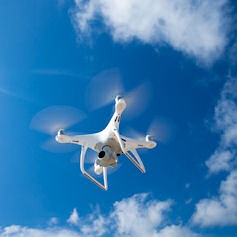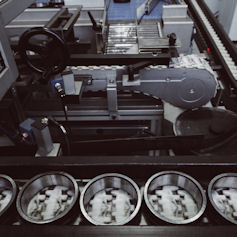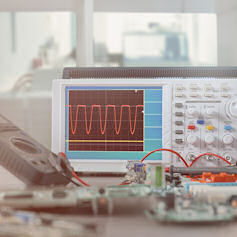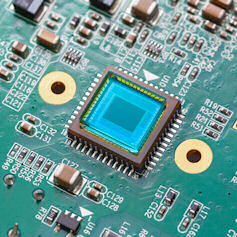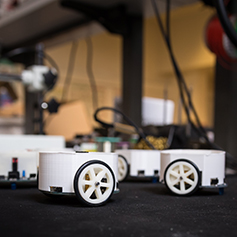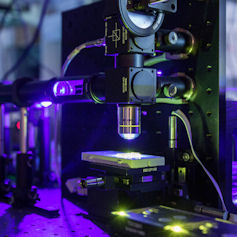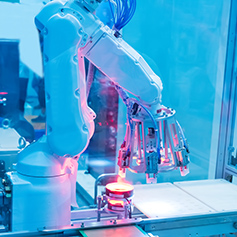
Electronic engineering for agriculture
Integrating sensors, electronics, control, power systems and ICT engineering into agriculture is a key enabler for delivering improved food supply and sustainable energy production without increased burden on the limited fertile land-bank.
Key researchers
This exploitation of non-traditional technologies to improve global farming is particularly timely given the projected growth in the world population.
The introduction of electronics in agriculture technologies into Agri-Food research, products and services requires new academic partnerships to be fostered across the University and elsewhere.
The activity is managed by a cross-disciplinary, industry and academic steering team that will also be tasked with delivering the longer term e-Agri strategy.
We are currently part of the following major projects:
- The N8 AgriFood programme
- The Global Food Security 'IKnowFood' project
- The STFC Food Network+
Key research topics
- Sensing above the crop: Hyper-weeding - on tractor hyperspectral sensors for high-speed detection and eradication of weeds
- Sensing below the roots: Low-cost networked soil moisture sensors to dynamically map the fluxes in moisture across field
- Sensing post harvest: The science behind 'sell by dates' - plastic electronic thermal sensors for printable RFIDs to track the perishable goods in the supply chain.
About e-Agri Manchester
This theme has the strategic aim of informing the electronics community of the needs of modern agronomy and food science to enable engineering of new systems and 'e'-devices for reducing waste, increasing yields and improving nutrition. Achievements include the establishment of the Syngenta University Innovation Centre, contribution to the Sustainable Agri-Food panel (Westminster, June 2011) and, with Syngenta and the BBSRC Rothamsted Research Centre, the first-ever successful demonstration in 2013 of a viable wireless sensor for fungal pathogens including Sclerotinia sclerotiorum - the most economically significant monocyclic crop disease in northern Europe.
Integrating sensors, electronics, control, power systems and ICT engineering into agriculture is a key enabler for delivering improved food supply and sustainable energy production without increased burden on the limited fertile land-bank. This exploitation of non-traditional technologies to improve global farming is extremely timely. In addition to climate change and overpopulation, the westernisation of world diets is producing even greater pressure on agriculture - approximately seven kg of grain is required to produce one kg of meat. Many of the benefits of fertilisation, irrigation and seed selection have already been realised and a new impetus is required to deliver the necessary yield improvements.
We believe that this impetus will come from sensor and ICT based control processes applied to agricultural processes. Electronics in agriculture research addresses the needs and problems of all stakeholders in the agriculture sector, from the farm to the shop: farmers and growers, seed and chemical providers, food logistics providers, agricultural machinery and equipment providers, food processors, suppliers and wholesalers and retailers. For each of these stakeholder groups, sensing and ICTs offer benefits to improve practices, raise yields, reduce costs, raise profit margins, secure food supplies and address the sustainability of the sector.
Vision
The vision of e-Agri is to look at the basics of farming and to understand what we actually need to be doing in order to deliver some solutions to the farming and food supply chain community.
We communicate with the farmers, plant scientists and genetics scientists to understand what they are trying to achieve and then re-engineer the basic devices. Therefore our intention is not to make some piece of equipment that sits in the lab doing detailed analysis; instead we hope to achieve a very different way of sensing directly in the fields. As sensing or controlling directly in the fields provides less specific and a much wider range of data, it tells more information about the fields and we believe this is the key to solve the growing food demand.
Mission
We partner up with all the enabling disciplines in the physical sciences band to get in-depth knowledge of a system.
We then as electronic engineers perform the work of an integrator - so basically putting together smart technologies together, be it a control system for robotics units that go around the field harvesting or a smart sensor built inside the smartphones that can pick up crop features/disease. The mission is to produce disruptive technologies - that is, the technologies that will actually make a difference in addressing the global challenges and assist the developing economies, especially the smallholder famers.
Coffee from advanced fermentation, engineering and sensing
Background
Coffee production is of great economic importance in Colombia, and particularly in the Department of Huila. In 2013 over 77,000 families in the Department were registered as
coffee 'micro-entrepreneurs' producing higher-added value specialty-coffees, principally for export. As a consequence, one in 14 of the total Huila population is currently directly reliant on specialty coffee production. Still there is vast unemployment, particularly among young people who have been inordinately affected by violence in the region over the past decades. Opportunities for talented young people to become coffee entrepreneurs and further improve the region's coffee-producing capabilities could provide a lifeline out of poverty and illegal activities.
Project aims
The coffee from advanced fermentation, engineering and sensing (CAFES) project identified parts of the coffee production system that could be improved by implementing evidence based monitoring and control. The fermentation of coffee cherries and subsequent drying of the coffee beans is often carried out by farmers and little was known about how the fermentation period might affect the taste and quality of the final product. The Institutional Links collaboration bringing together the agronomy and instrumentation engineering disciplines within Universidad SurColombiana and Universidad de los Andes, with the agri-sensor systems, analytical and process engineering capabilities in The University of Manchester allowed us to investigate how controlling on-farm fermentation affects the final coffee taste. This knowledge will help to produce low-cost sensors, basic equipment and training materials that could be used on farms to improve the quality of the final product, reduce waste and increase profit.
Future work
We are working to continue the development of the local coffee research centre and to advance the skills of local coffee farmers. The eventual aim is to achieve a fully transparent, traceable coffee supply chain from crop to cup, providing specialty, high-quality coffee to the emerging artisan coffee market in a way that empowers the producers.
Crop disease detection for smallholder farmers
e-Agri in developing countries
This concerns applying close-proximity hyperspectral imaging of the early onset of crop diseases to minimise preventable losses in emerging food production via the application of contemporary concepts into a new low-cost mobile attachment.
There is a significant yield gap for agricultural crops in developing countries versus those in the west, where mechanisation and agricultural technologies have a far greater adoption. Pest and fungal disease can have a significant impact on these yields and overall profitability, resulting in many cases to adversely affected livelihoods due to poor decision making in the lack of effective knowledge.
Paired with a rising uptake of new inexpensive smartphones in the developing market, due to availability and farming trade information access, this makes for an exceptional framework on which to develop new technologies to better manage fungal and bacterial diseases that may reduce future harvests.
The challenges
It can be very difficult to correctly identify the infiltration and spread of a fungal pathogen in time to prevent major economic impact. Given the scale and diversity of crops, varieties and diseases, even the most experienced of farmers can incorrectly diagnose. This typically results in one of two negative outcomes:
- scheduled pesticide spraying where it is not needed;
- late spraying to minimise yield loss.
With an automated diagnosis compared against a growing database of known pests/pathogens, this problem could be resolved. However, it would be impracticable to develop the breadth of data in laboratories to be able to effectively diagnose in the field. Therefore initial trials using a data mining version would be necessary, both initially and periodically, to update the results.
Smartphone to fight crop disease
Supported by EPSRC, the Department of Electrical and Electronic Engineering is partnering with a small Anglo-Indian company, Barefoot Lightning Ltd (BfL), to develop a very low-cost sensor system for close-proximity hyperspectral imaging of the early onset of crop diseases.
It is closely linked with the work done in conjunction with the University of Bonn, where we managed to replicate results by replacing a high-cost spectrometer with low-cost narrow band emitters.
How it works
A low-cost tool will be able to scan for disease signatures, ie spectral and spatial signals, and the results compared against known values.
In the field it can be put in the hands of field extension workers, semi-technical staff employed by agronomy companies, NGOs and/or regional government bodies.
Extension workers may then scan plants for disease signals already stored in BfL's libraries or, where new disease signals are found, they can be added to the libraries, thus enabling BfL to build up the database and simultaneously providing an early warning system.
BfL will also make use of the same technology to look for plant disorders such as nutrient deficiencies, so creating a high-value dataset relating crop-stress to hyperspectral data, which may then be exploited further by academic groups and/or marketed to agronomy companies.
Other applications
Disease signals expanded libraries can also then be used in the simpler 'farmer versions' to allow them to search for early warning signs of disease in their fields.
BfL will also make use of the same technology to look for plant disorders such as nutrient deficiencies, so creating a high-value dataset relating crop-stress to hyperspectral image data. The latter may then be exploited further by academic groups and/or marketed to agronomy companies.
Future development
Although the pilot market is in India due to existing industrial infrastructure, the smartphone based technology has the potential to impact global farming communities, food supply and even animal wellbeing.
In particular the e-Agri team is looking into extending the sensors for use in plant virus control in Sub-Saharan African cassava farming, alongside colleagues in the University of Greenwich and the Bill and Melinda Gates Foundation.
Broader implications for animal and human health assessment are also being developed, notably with the University of Liverpool and the University of Leeds. In the longer term there are plans to bring the technology into the hands of growers in the UK to help the growing community of home producers of food.
The opportunities are very broad and the team is always working on new ideas.
The E-Agri Sensors Centre
Since its formation in November 2000 from the merger of the AstraZeneca and Novartis crop science businesses, the e-Agri Sensors Centre has significantly refocused its research activities to meet the projected needs of agriculture and food supply. In light of this a number of strategic enabling technologies have been identified that can facilitate innovative new approaches to crop growth and non-mammalian biotechnology. Sensor science is one of these technologies identified as having the capacity to create a paradigm shift in the future of the sector. To realise this potential the e-Agri Sensors Centre model has been developed.
The Centre has been strategically domiciled within a university environment so as to nurture and translate the underpinning sciences (from across the physical and life-sciences interfaces) that will be required to deliver future agricultural products and services. The Centre is based within the Department of Electrical and Electronic Engineering in the Faculty of Science and Engineering, but is necessarily multidisciplinary owing to the nature of the techniques being researched.
Research aims
The e-Agri Sensors Centre is researching sensing systems and information communications technologies for agriculture and farming, but with a central focus on sensors and knowledge-based approaches to support agriculture and farming of the future. Within this remit, the Centre is working in several areas, including:
- new sensing technologies;
- RFID;
- wireless sensor network;
- energy harvesting;
- information and knowledge management.
The Centre has a strategic interest in defining the ICT infrastructure and platforms for farming and agriculture, and identifying the actions and research necessary to bring about the realisation of this ICT infrastructure. The Centre is also interested in the farm-to-fork supply chain and how the technologies of interest can help to improve food quality and reduce environmental burdens.
Significant achievements
- Delivered the first commercial networked crop-disease biosensor
- Created the e-Agri brand and hosted the landscaping event, led by the UK Chief Government Scientist
Early clubroot identification
Clubroot (Plasmodiophora brassicae) is an important pathogen of Brassica crops including oil seed rape (OSR), both in the UK and worldwide. Clubroot infection occurs via root hair penetration (primary infection) and root cortex invasion (secondary infection), and leads into typical above and below-ground disease symptoms.
Infected plants develop large galls in the root system while above-ground symptoms include wilting, stunting, chlorosis, premature senescence and, in severe cases, death. All symptoms are caused through gradual changes in primary and secondary host metabolism, alterations in cambial stem cell maintenance and differentiation, and perturbations of vascular development with reduction in xylogenesis.
Project aims
The aim of the project is to use EIT to directly measure below-ground responses as a complementary method of identifying quantitative resistance to clubroot infection in Brassica crops. Infection leads to an inhibition of lateral root formation, repression of xylogenesis, a localised induction of vascular cambium activity leading to gall formation and altered water relationships, all of which can potentially be measured and quantified using EIT.
Project applications
The existing technology is to take X-ray images of the roots. This technology is fairly accurate, however it is very expensive and out of reach for most farmers. Thus the idea is to build a technology that is relatively cheap, thereby allowing all the dominions of the farming community to tap into this technology and detect/eliminate club roots at an earlier stage.
Polymer sensors for remote nutrient detection in agriculture
Project aim
The aim of the research is to produce biomimetic polymer sensors that can be used in a remote monitoring system to quickly and selectively detect the concentration of in-field macronutrients (such as phosphates and nitrates) in soils and aqueous growth media.
Research applications
This is of significant interest within the food and agriculture sector as it has the potential to provide agronomists with a rapid, simple-to-use and cost-effective alternative to traditional laboratory techniques for the precise measurement of nutrient concentrations in growth media and soils.
The research at The University of Manchester is focusing on producing a novel sensor system for use in hydroponics, so as to provide a measurement and feedback system. This aims to carefully monitor and control the dosing of nutrients into the growth media, and thus provide the conditions for an optimal crop yield.
Future works
The polymer material is being continuously optimised to suit the target analyte, and the reusability and robustness of the synthetic films is of significant interest. Producing a reversible polymer sensor that can produce multiple readings would be of significant interest, allowing for further automation of a monitoring system.
Reusable nutrient sensors in commercial hydroponic farming
Nutrient sensors are used to control phosphates and nitrates levels; molecularly imprinted polymer sensors for the detection of macronutrients in agriculture.
Project aims
The aim of the research is to produce biomimetic polymer sensors that can be used in a remote monitoring system to quickly and selectively detect the concentration of in-field macronutrients (such as phosphates and nitrates) in soils and aqueous growth media.
Future development
The polymer material is being continuously optimised to suit the target analyte, and the reusability and robustness of the synthetic films is of significant interest.
Producing a reversible polymer sensor that can produce multiple readings would be of significant interest, allowing for further automation of a monitoring system.
Applications
This is of significant interest within the food and agriculture sector as it has the potential to provide agronomists with a rapid, simple-to-use and cost-effective alternative to traditional laboratory techniques for the precise measurement of nutrient concentrations in growth media and soils.
The research at The University of Manchester is focusing on producing a novel sensor system for use in hydroponics, so as to provide a measurement and feedback system. This aims to carefully monitor and control the dosing of nutrients into the growth media, and thus provide the conditions for an optimal crop yield.
Industrial partners
A series of videos explaining the research we carry out is available on the e-Agri YouTube channel and more information is available through our Agrifood Twitter account.
Areas of expertise
-
Autonomous systems
We develop innovative scientific methods that lead to technologies requiring minimal human intervention.
Read more
-
Communications
We work on multidisciplinary approaches to problems in highly mobile communications, cognitive radio, RF and more.
Read more
-
Control systems
Our work focuses on the development of control design methods and process monitoring and diagnostics.
Read more
-
Digital signal processing
We make sensor instrumentation and algorithms for extracting information from raw data.
Read more
-
Electronic devices
Our work spans the modelling and synthesis of atomic layer thin films using Molecular Beam Epitaxy.
Read more
-
Mechatronics
We specialise in electromechanical technologies for renewable energy systems and electric vehicles.
Read more
-
Photonics
Our researchers work across all areas of photonics, including the development of new advanced materials.
Read more
-
Sensors and sensing systems
Our work includes developing new sensors and designing systems and integration tools.
Read more
-
Systems integration
We work on systems integration across all levels, from low-power applications to high voltage systems.
Read more

